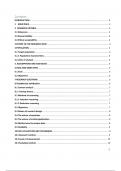Presentation
COM3706_ASSESSMENT_PORTFOLIO.
- Course
- Institution
COM3706_ASSESSMENT_PORTFOLIO. INTRODUCTION In South Africa woman die in the hands of their partners, the issue of femicide is a serious matter. In this research we investigate how woman are killed by their partners and how the media represent them. This will be done by using the ten femicide...
[Show more]



